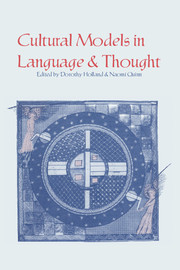Book contents
- Frontmatter
- Contents
- Preface
- List of Contributors
- Introduction
- Part I Presupposed worlds, language, and discourse
- Part II Reasoning and problem solving from presupposed worlds
- 6 Proverbs and cultural models
- 7 Convergent evidence for a cultural model of American marriage
- Part III The role of metaphor and analogy in representing knowledge of presupposed worlds
- Part IV Negotiating social and psychological realities
- Part V An appraisal
- Index
7 - Convergent evidence for a cultural model of American marriage
Published online by Cambridge University Press: 05 June 2012
- Frontmatter
- Contents
- Preface
- List of Contributors
- Introduction
- Part I Presupposed worlds, language, and discourse
- Part II Reasoning and problem solving from presupposed worlds
- 6 Proverbs and cultural models
- 7 Convergent evidence for a cultural model of American marriage
- Part III The role of metaphor and analogy in representing knowledge of presupposed worlds
- Part IV Negotiating social and psychological realities
- Part V An appraisal
- Index
Summary
This paper analyzes two passages excerpted from a longer interview, illustrating the utility of a method of discourse analysis elsewhere (Quinn 1985a; 1985b; n.d.) applied to much more extensive interview material of the same sort. In the larger study from which these excerpts have been borrowed, husbands and wives in 11 marriages were interviewed, separately, over an average of 15 or 16 hours each, on the topic of their marriages. Interpretation of the passages at hand draws on the more extended analysis of this entire body of material. The full analysis depends for its convincingness on its ability to account for features of discourse about marriage in many passages such as those examined here. Of course, the entire analysis cannot be presented in this brief paper, but the examples provided suggest its range. The two segments of discourse scrutinized here, one of which followed the other about midway through the first hourlong interview with a woman whom we call Nan, are reproduced below:
3 W-1: I think Tom and I both were real naïve about each other. I mean, I think that we got married on the strength of a lot of similar tastes and a lot of love and appreciation but not much real sense of who each other were. I really don't think that we, either of us, had examined each other and said – I mean, I don't think I had said, “Really, who is this Tom Harper, how can I describe him, what is he?
- Type
- Chapter
- Information
- Cultural Models in Language and Thought , pp. 173 - 192Publisher: Cambridge University PressPrint publication year: 1987
- 86
- Cited by



